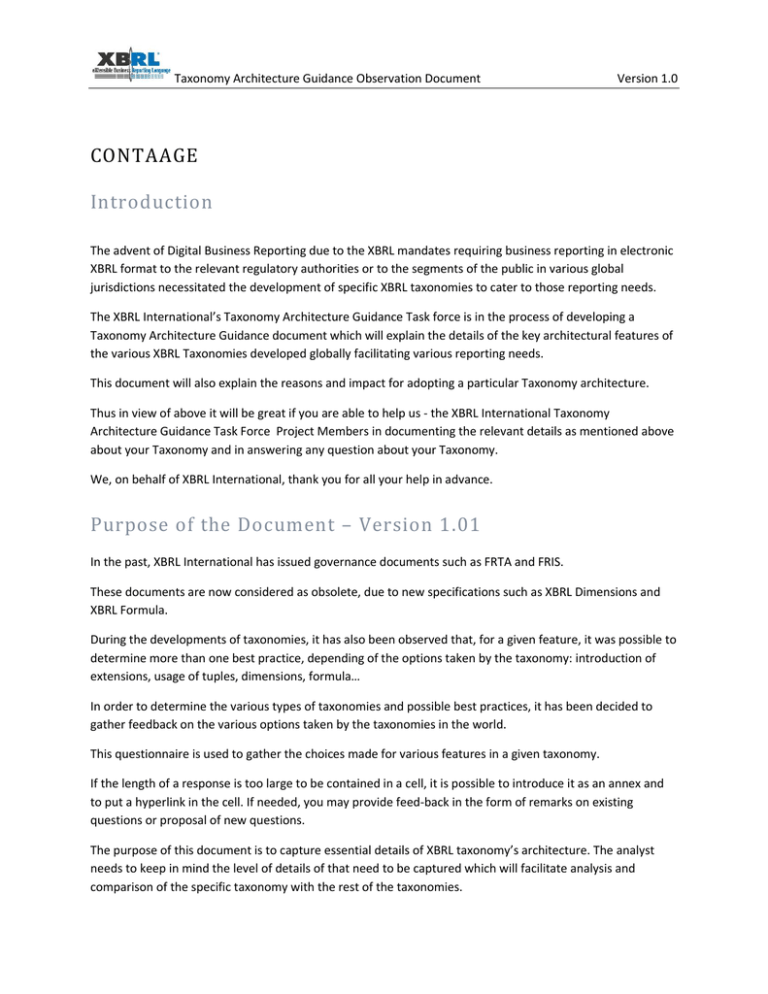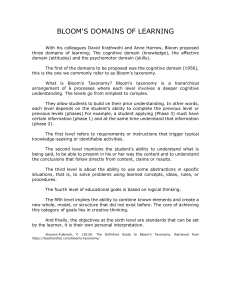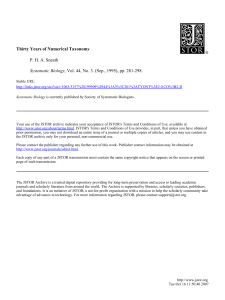Purpose of the Document - Asociación XBRL España
Anuncio

Taxonomy Architecture Guidance Observation Document Version 1.0 CONTAAGE Introduction The advent of Digital Business Reporting due to the XBRL mandates requiring business reporting in electronic XBRL format to the relevant regulatory authorities or to the segments of the public in various global jurisdictions necessitated the development of specific XBRL taxonomies to cater to those reporting needs. The XBRL International’s Taxonomy Architecture Guidance Task force is in the process of developing a Taxonomy Architecture Guidance document which will explain the details of the key architectural features of the various XBRL Taxonomies developed globally facilitating various reporting needs. This document will also explain the reasons and impact for adopting a particular Taxonomy architecture. Thus in view of above it will be great if you are able to help us - the XBRL International Taxonomy Architecture Guidance Task Force Project Members in documenting the relevant details as mentioned above about your Taxonomy and in answering any question about your Taxonomy. We, on behalf of XBRL International, thank you for all your help in advance. Purpose of the Document – Version 1.01 In the past, XBRL International has issued governance documents such as FRTA and FRIS. These documents are now considered as obsolete, due to new specifications such as XBRL Dimensions and XBRL Formula. During the developments of taxonomies, it has also been observed that, for a given feature, it was possible to determine more than one best practice, depending of the options taken by the taxonomy: introduction of extensions, usage of tuples, dimensions, formula… In order to determine the various types of taxonomies and possible best practices, it has been decided to gather feedback on the various options taken by the taxonomies in the world. This questionnaire is used to gather the choices made for various features in a given taxonomy. If the length of a response is too large to be contained in a cell, it is possible to introduce it as an annex and to put a hyperlink in the cell. If needed, you may provide feed-back in the form of remarks on existing questions or proposal of new questions. The purpose of this document is to capture essential details of XBRL taxonomy’s architecture. The analyst needs to keep in mind the level of details of that need to be captured which will facilitate analysis and comparison of the specific taxonomy with the rest of the taxonomies. Taxonomy Architecture Guidance Observation Document Version 1.0 Please note that the items marked with * were considered as mandatory to report. General 1.0 Context of the taxonomy If needed, explanations about the taxonomy and its context Administración General del Estado. España * 1.1 Purpose of the taxonomy (disclosure/GAAP) What is the purpose of the taxonomy? Is it for Business reporting? Financial reporting? External disclosures? Corporate actions? Or does it represent the accounting standards of a jurisdiction? Reportes financieros de la información a rendir al Tribunal de Cuentas según la Orden EHA/3067/2011 de 8 de Noviembre por la que se aprueba la Instrucción de Contabilidad para la Administración General del Estado (ICAGE). * 1.2 Type of data represented Related to 1.1, what kind of data does the taxonomy store? Is it business reporting data? Transactional data? Or both, does it have numbers or textual content or both? Reportes financieros Closed or open taxonomy? Extensions allowed? Taxonomía abierta, admite extensiones. * 1.3 Has the taxonomy been used to be closed or open? Is it being used in a mandate where extensions to the taxonomy are allowed? Are the extensions mandatory? * 1.4 1.5 Contenido numérico y textual Hereda gran parte de su definición de la taxonomía CONTAEPA Stakeholders of the taxonomy. Propietario: IGAE Who are the owners, and users of the taxonomy? For example, a GAAP taxonomy adopted by a securities regulator, and extended to have its own reporting requirements and being used by companies to report, and investors to consume data will have stakeholders like the accounting standards setter, securities regulator, reporting platform creator, companies, investors etc. Usuarios: Administración General del Estado, Tribunal de Cuentas Business case details The business requirements could be a very detailed response added as an annexure, like the given example. 1.5.1 Number of expected users Number of users of this taxonomy, including all stakeholders. 1.5.2 Expected Costs Costs that have incurred, any budgetary details if available. 1.5.3 Quantified Benefits 30 Taxonomy Architecture Guidance Observation Document Version 1.0 Were they any quantified benefits achieved once the XBRL system was adopted? Fill only if available and relevant to the taxonomy. 1.5.4 Other Expected Benefits Normalización de la información Tratamiento automatizado de los datos Adopción de nuevos estándares y el posicionamiento que esto implica en el sector. * * 1.5.5 Actual experience as compared to above expectations 1.5.6 Other 1.6 How mature is the taxonomy? 1.6.1 Number of versions Number of versions of the taxonomy that have been created, what was the frequency of version creation? 1.6.2 Time since used Since how long the current taxonomy in question has been used? All the versions, if possible you could provide a version breakdown. Number of instances 1 Expectativas: cada versión estable durante, al menos, un año Versión 1.0: en uso desde Julio 2012 * 1.6.3 * 1.7 Base Language? What is the base language of the taxonomy? Which means what language are the XML tags, and the documentation created in? What are the other language labels does the taxonomy have? Español * 1.8 Is there a filing manual? Taxonomy guidance document? Sí. Accesible desde la página web de la taxonomía: Has a filing manual been provided? How detailed is it in terms of providing taxonomy details? Attach the document or link to access the document if possible. * 1.9 1 Enlace a taxonomía Statistics Total number of concepts Primary item 1949 Taxonomy Architecture Guidance Observation Document Version 1.0 Dimensions Hypercubes Domain members * 1.10 Tuples 104 Others Nuevos atributos y tipos de datos. 5 Industries covered? Contabilidad pública What are industries covered? Provide as standard names as you can. * 1.12 Common reporting practices included?-Are concepts defined on common reporting practices or standards or both? Some taxonomies, especially financial reporting do not contain common reporting elements. Mention if they do or they don’t. * 1.13 XII recognition status 1.14 Other comments 1.15 Link to the taxonomy Normativa de contabilidad pública: Plan General de Contabilidad Pública Enlace a taxonomía If the taxonomy is publicly available, please specify where it can be found Overall Architecture * 2.1 Entry points Un único punto de entrada Single, Multiple, No Specific Entry points example COREP Taxonomy? How many? Los nombres de ficheros no incluyen referencia a la versión By industry, by standards, by type of period, by type of entity (related to proportionality), by language(s) Minimum tagging entry-point Could be used directly (clarification required) Includes version information in filenames (e.g. date) * 2.2 Folder & file structure How are the schema and linkbase files created? How are the segregated? How are they stored in a folder? You could add the folder structure diagram to the annexure for details. Se define un esquema taxonómico por cada modelo financiero a reportar, y varios esquemas taxonómicos que agrupan a su vez esos esquemas simples Taxonomy Architecture Guidance Observation Document Version 1.0 conceptualmente Se anexa un diagrama de estructura al final del documento Anexo 1 * 2.3 Is the architecture based on a form design? Sí Does the taxonomy architecture directly mimic the disclosure forms? Which means that the linkbase structures, folder structures, schema files, labels etc will be form specific, this could also mean that there might not be normalization done across forms. Provide your comments and observations. * 2.4 How have namespaces been used within the taxonomy? Does the namespace signify anything in the taxonomy? What does it represent? Representan: ejercicio contable y modelo financiero * 2.5 Is the taxonomy in one namespace? Are different 'sections' of the 'same' taxonomy in different namespaces? Are there multiple namespaces from importing external taxonomies? Un namespace por cada esquema taxonómico. Cada esquema taxonómico representa un modelo financiero a reportar * 2.6 Versioning methodology? El versionado se representa mediante la iteración de información numérica que forma parte del nombre de la taxonomía. Versions include date? Renaming of files for new versions Do element names remain constant over taxonomy versions? Frequency of new versions Existe un documento de control de cambios que asocia ese nombre de la taxonomía a la fecha de puesta en producción de la versión y detalla las novedades con respecto a versiones anteriores. Los ficheros no incorporan versión en su nombrado, solo lo incorpora la carpeta contenedora. Estimación de frecuencia de versiones: 1 al año * 2.7 To what extent are context periods expected to vary throughout the report? e.g. current reporting period and comparative reporting periods No. Los contextos representan siempre un ejercicio contable que es, por lo general, un año. * 2.8 Conformance to FRTA Parcialmente. No se cumple la FRTA en cuanto a las recomendaciones Taxonomy Architecture Guidance Observation Document Version 1.0 Is the taxonomy complying with FRTA, or intends to comply with FRTA. If it does not what kind of clauses of FRTA or exactly which ones it does not comply with. Do they have it documented? de límite de caracteres en los prefijos de los elementos. * 2.9 Conformance to any other best practices (GFM, EFM etc.) Buenas prácticas en cuanto a mecanismos de nombrado de elementos. * 2.10 What meaning is ascribed to the Entity context element? El contexto recoge el nombre e identificador de la entidad que reporta la información. * 2.11 Whether there is separate documentation reflecting on the architecture of the Taxonomy and location of the document? Or everything is in the same one. Details Schema * 3.1 Naming convention for element names? What is the naming convention of the element name? Is some convention being followed? Is it LC3 or have the authors created their own convention, if yes then what is the convention and what purpose does this convention serve. Se ha seguido el sistema L3C (Label CamelCase Concatenation), sin signos de puntuación. Dado el tamaño de la taxonomía, un requisito fundamental era mantener para cada elemento el nombre de sus antecesores, de manera que para un elemento aislado se sepa a qué modelo y qué epígrafe pertenece y lo identifique unívocamente en la taxonomía. Esto se consigue concatenando el nombre del padre como prefijo del hijo y separado por barra baja, y así sucesivamente en cada nivel de Taxonomy Architecture Guidance Observation Document Version 1.0 desglose. * 3.2 Are namespaces stable across versions of the taxonomy? Sí * 3.3 Is the balance attribute used to define the monetary items? No * 3.4 Are there concept(s) which should be normally negative? Sí * 3.5 Have any additional XBRL standard data types (apart from the normally used monetary, shares etc?), have the non-num and num data types libraries be used? Uso fundamentalmente de tipo string y monetario. Have any new unconventional data types created. Se han creado nuevos tipos de datos en un fichero .xsd independiente y que dan soporte a necesidades de negocio de la taxonomía. * 3.5 Is the type registry schema (dtr.xsd) used? No * 3.6 New arcroles? No Have any ne arcoles been created? If yes, then which linkbases are they being used and why have they been created? * 3.7 Separate schema files for element declarations? If so, then what are they criteria of differentiation? Sí, los elementos están agrupados en base a los modelos financieros a los que se refieren. * 3.8 Dimensional and non-dimensional elements - are defined in same schema? Or separate schema No existen elementos dimensionales * 3.9 Have any new attributed been created? Sí * 3.10 Do the attributes require software applications to custom build an interpretation of they are for informative purpose? If so, then what? Ambos casos. * 3.11 Do any of the data types require customization in the application? Or can the base xml schema spec be enough for interpretation? Es suficiente el schema base XML para su interpretación * 3.12 Extended link roles "Separate schema files for extended link roles? Taxonomy Architecture Guidance Observation Document * 3.13 Naming style for ELR Id, URI? Is it a standard convention that everyone is following? (Namespace/role/Id)? Or is it different? * 3.14 Is used on selected for all linkbases? Irrespective of the extended link being used in the linkbase or not? * 3.15 Are sort codes used in ELR definitions? What is the pattern * 3.16 Generic linkbase used to provide definitions for ELRs (in IFRS taxonomy)" Version 1.0 Label Linkbase * 4.1 Multiple languages? Multiple files? Single file? Un único lenguaje. * 4.2 Standard label construction convention? Sí * 4.3 Are labels concatenated based on other relationships to give a long, unique and descriptive label? No * 4.4 New label roles created? No What are the purpose(s) of the label? * 4.5 Are the labels unique? Sí * 4.6 Are preferred, negated, total or other labels used, does the presence of these give specific meaning to the concept? Uso de etiquetas de totales. * 4.7 Are documentation labels present? No What purpose do documentation labels and references serve? How do they achieve that purpose? - e.g. Contain reference text or pointers to Taxonomy Architecture Guidance Observation Document Version 1.0 references? How is it proposed to maintain these documentation labels and who controls changes? * 4.8 Is style guide for labels available? No * 4.9 Do all items have a label - including hypercube items, dimension items, domain members, tuples ? Sí * 4.10 Is the generic linkbase used for labels? Is a generic linkbase used rather than a label linkbase Se usa la linkbase genérica. Reference Linkbase * 5.1 Are there reference linkbase(s)? * 5.2 Is the standard reference part schema used? * 5.3 Are alternative reference part schema(s) provided? * 5.4 Reference roles used? * 5.5 References defined in one file, or modularized based on schema? or standards? * 5.6 References defined for all elements? Or only non-abstract, but including axis, tables and members? * 5.7 Are they any references created for Extended Link Roles (ELRs)? * 5.8 Is order attribute used for references? No se usa Taxonomy Architecture Guidance Observation Document Version 1.0 Is there a sequence for reference parts? * 5.9 Do references complement or replace documentation labels? What is the stated purpose of the reference linkbase? * 5.10 Are URLs or text Note references used? If so, how are they constructed and maintained? * 5.11 Is generic linkbase used for references? s Is a generic linkbase used rather than a reference linkbase? Presentation Linkbase * 6.1 Grouped by accounting standards/regulatory authorities-Separate ELRs to represent the different accounting standards of reporting or for common reporting practices or for separate disclosures? Las presentaciones viene agrupadas en base a los modelos contables definidos por el PGCP * 6.2 Any elements remain unused in presentation linkbase? No * 6.3 What is the stated purpose of the Presentation linkbase? Ofrecer una visualización de los datos de la instancia similar a la que presentan los modelos del plan financiero * 6.4 Does preferred role being used to specify? Or require any kind of interpretation? Like the negated? Definition Linkbase * 7.1 Is the dimensional hierarchy aligned against the presentation? * 7.2 Is the segment element, the scenario element or both used? Are multiple base sets used? No se usa Taxonomy Architecture Guidance Observation Document * 7.3 Are multiple domains used? * 7.4 * 7.5 Are the dimension members hierarchised? Are there domain members that are not usable? * 7.6 Are inclusive hypercubes closed (closed attribute set to "true")? * 7.7 Are negated hypercubes (notAll arcrole) used? Why or why not? * 7.8 If so, are negated hypercubes closed (closed attribute set to "true")? * 7.9 Are hypercubes reused in the DTS? Extent of reuse? * 7.10 Are hypercubes defined in their own extended link role (ELR)? * 7.11 What is the usage of the targetRole attribute in the sequence of dimensional arcs? * 7.12 Are dimensions redefined in the hypercubes? * 7.13 If so, are they hierarchised? * 7.14 Are there empty hypercubes? * 7.15 Are there hypercubes with an empty dimension (forbidding Version 1.0 Taxonomy Architecture Guidance Observation Document Version 1.0 hypercube)? * 7.16 * 7.17 Are all the dimensions applied to primary items? Or there are some dimensions kept open to be applied? Is definition linkbase used for non-dimensional relationships? Calculation Linkbase * 8.1 Are the weights limited to -1 and 1? (Yes/No) * 8.2 If no, then what are they used for? * 8.3 Does the filing rule specify decimals or precision or both? (decimals/precision/both) No se usa Formula Linkbase * 9.1 Is XBRL formula technology used? * 9.2 Have assertions been used? * 9.3 Have formulas been used? * 9.4 Does it have computation formula calculations? * 9.5 Is every assertion or formula identified? * 9.6 Is there a convention for the identification of assertions / formulas? * 9.7 Are tolerance margins used? * 9.9 How are tolerance margins defined? * 9.10 Are generic messages used? * 9.11 Are assertions used together with calculation linkbase hierarchies? No se usa Taxonomy Architecture Guidance Observation Document Version 1.0 Data Models * 9.1 Single axis tables? How have they been modeled? Simple hierarchies, Tuples, Typed Dimensions or explicit dimensions-How a list is modeled? Este tipo de tablas son modeladas mediante el uso exclusivo de ítems, usando un elemento ítem para recoger la información de cada celda de la tabla. * 9.2 Multiple axis tables? How have they been modeled? How a matrix is modeled? Las tablas de tipo matriz se representan mediante el uso de tuplas e ítems. Si la matriz es fija en cuanto a su número de filas, se utilizan únicamente ítems. Representando cada ítem el cruce de una fila con una columna. Si el número de filas es variable, cada elemento fila se representa con una tupla. El content model de esa tupla viene dado por tantos ítems como columnas tenga la fila. Podremos tener de 0 a n tuplas, siendo cada tupla el reflejo de una fila. * 9.3 Textual data? With numbers/dates? Ambos * 9.4 How are roll up calculations modeled? * 9.5 How are roll-forward (movement analysis) calculations modeled? * 9.6 Mandatory and non Mandatory disclosures?-Methods of enforcing mandatory disclosures. * 9.7 Business rules represented-Methods of representing business rules through formulas, formal presentation structure of the financial statement or report, calculation linkbases and other external mechanism * 9.9 Multiple disclosure reports?-Whether it accomplishes the task of filing to multiple regulatory agencies for example HMRC and the Companies house * 9.10 Does the taxonomy cover a single purpose/form or multiple? * 9.11 Does the taxonomy cover the requirements of more than one user? * 9.12 Definition linkbase used for? * 9.13 What meaning does instant and duration have? Únicamente utilizamos contextos de tipo instant para representar la Taxonomy Architecture Guidance Observation Document Version 1.0 fecha de cierre del ejercicio contable al que se refieren los datos financieros enviados en la instancia XBRL * 9.14 What period type(s) are used for narrative items? * 9.15 What period type(s) are used for dates? Instant * 9.16 What period type(s) are used for abstract items? Instant * 9.17 How are balancing items ("other" in a list) modelled? * 9.18 How are other participants in the report content modelled? Taxonomy Owner Details Name IGAE Contact details Contaepa@igae.minhap.es Organization IGAE Comments TAG-TF Analyst Details Analyst Name Área de Cuenta General y Cuentas Económicas. IGAE. Time taken 3 horas Taxonomy Architecture Guidance Observation Document Date Comments 28-08-2012 Version 1.0 Taxonomy Architecture Guidance Observation Document Anexo 1: Estructura modular de la taxonomía Back Version 1.0





